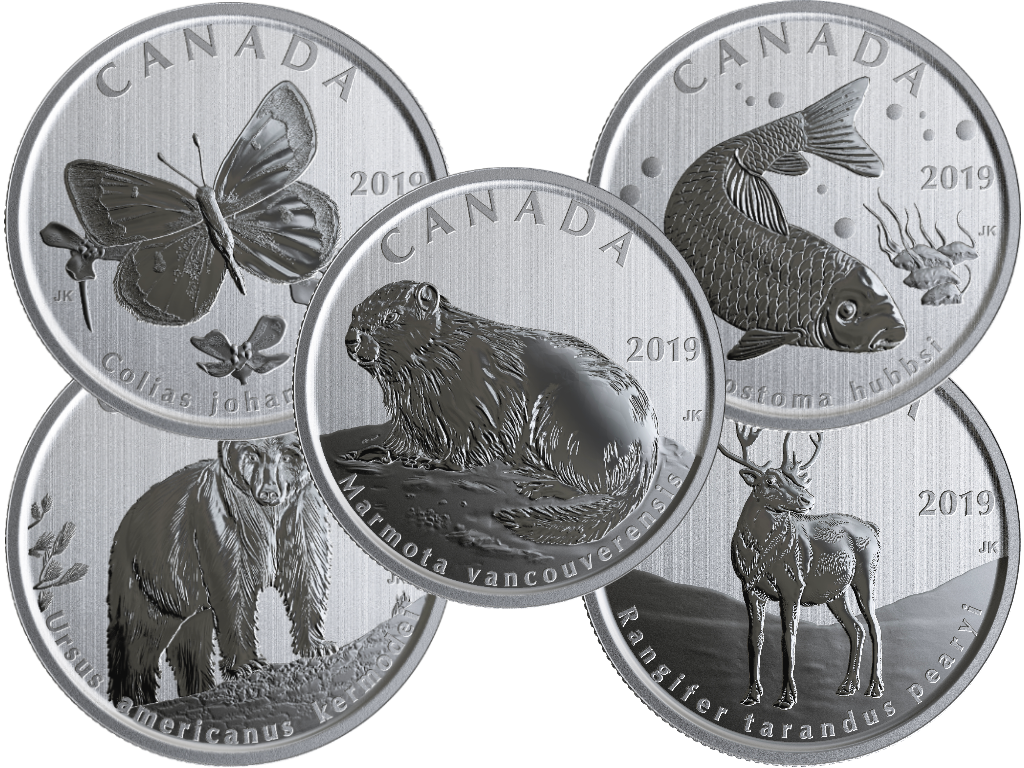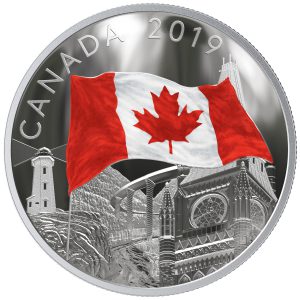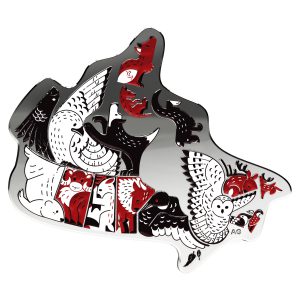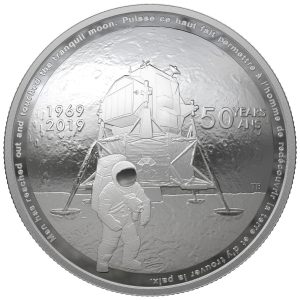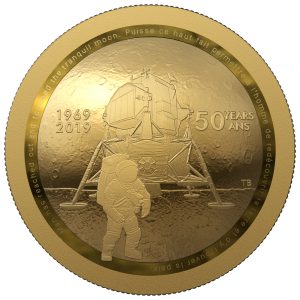As the nation geared up for Canada Day celebrations on July 1, the Royal Canadian Mint issued its latest monthly numismatic catalogue, this featuring 15 coins plus an additional five-coin set entitled “Canada’s Wildlife Treasures.”
With five 50-cent nickel-plated steel coins designed by Joel Kimmel, the “Wildlife Treasures” set features five of Canada’s roughly 286 endemic species, most of which have never appeared on a Canadian coin. Billed by the Mint as “a fun educational tool to introduce young Canadians to their animal neighbours or to a potential lifelong hobby,” the coins are housed in a colourful folder with insightful facts and a map.
“The Royal Canadian Mint is doing its part by producing the Canadian endemic animal coin collection showcasing some of the magnificent animals that call Canada home to help raise awareness,” said Dolf DeJong, CEO of the Toronto Zoo, which collaborated with the Mint on the “Wildlife Treasures” set.
“It is so important to preserve biodiversity on this planet and as Canadians, we are the guardians of the plants and animals found only in our country. We need Canadians from coast to coast to coast to work together to learn about these species and do everything we can to preserve these national treasures.”
The set includes:
- the Johansen’s sulphur butterfly (Colias johanseni);
- the Peary caribou (Rangifer tarandus pearyi);
- the copper redhorse (Moxostoma hubbsi);
- the Vancouver Island marmot (Marmota vancouverensis); and
- the Kermode bear (Ursus americanus kermodei).
Each of the coins has a weight of 6.9 grams and a diameter of 27.13 millimetres, and there’s a mintage of 100,000 sets.
‘FABRIC OF CANADA’
Other highlights of the Mint’s July catalogue include a $30 Fine silver coin, “The Fabric of Canada,” which features first-of-their-kind undulating obverse and reverse fields.
Designed by artist Rebecca Yanovskaya, the undulating coloured Canadian flag is shown on the coin’s reverse, where it realistically flutters above national landmarks, including Parliament Hill’s Peace Tower in Ottawa; Peggy’s Point Lighthouse in Nova Scotia; and Kicking Horse Canyon in the British Columbia interior.
“The undulating effect on this coin is a great example of what I love about my work as an engraver,” said Alex Tirabasso, Mint artist and engraver. “It’s a chance to explore new ways to enhance the beauty and uniqueness of a coin using advanced technology.”
Canada began exploring the idea of replacing Great Britain’s Royal Union Jack with its own flag in the late 1800s, and while the issue was taken up by formal committees over the decades that followed, the project always stalled.
In 1964, with Canada’s centennial only three years away, then Prime Minister Lester Pearson formed the committee that ultimately chose the now-famous red maple leaf design.
Queen Elizabeth II lent the design her formal proclamation on Jan. 28, 1965, and the flag was inaugurated on Feb. 15, 1965.
The “Fabric of Canada” coin has a weight of 62.69 grams, a diameter of 50 millimetres and a mintage of 2,500 pieces.
CANADIAN LANDSCAPE
Sharing her unique vision of Canada, artist Alisha Giroux created a collage of storybook-style illustrations evoking the boundaries of our provinces and territories on a $50 Fine silver coin, “The Canadian Landscape.”
The first Canada-shaped coin, it features stylized birds and mammals forming the shape of each province and territory they represent. From left to right, these icons of the Canadian wilderness include:
- a raven (Yukon);
- a Kermode bear (British Columbia);
- a gyrfalcon (Northwest Territories);
- a bighorn sheep (Alberta);
- a white-tailed deer (Saskatchewan);
- a Canadian Inuit dog (Nunavut);
- a plains bison (Manitoba);
- a common loon (Ontario);
- a snowy owl (Quebec);
- a chickadee (New Brunswick);
- an osprey (Nova Scotia);
- a blue jay (Prince Edward Island); and
- a woodland caribou (Newfoundland and Labrador).
“Having always seen animals and other creatures in the provincial shapes that make up my country, I expanded on this idea to create an illustrated map of Canada,” said Giroux. “Each province and territory is reimagined as an animal or bird, all while keeping true to the shapes and borders. It’s a surreal experience to see your artwork minted onto a coin, and I’m immensely grateful for the opportunity.”
This coin has a weight of 100 grams, a diameter of 73 millimetres and a mintage of 2,000 pieces.
APOLLO 11
A lesser-known story of Canadian know-how and ingenuity lies behind one of history’s biggest achievements, which is celebrated on a pair of convex gold and silver coins marking the 50th anniversary of the Apollo 11 Moon landing.
Designed by artist Tony Bianco, a $25 silver coin and $100 gold coin feature the lunar module that transported the first astronauts to the surface of the Moon in July 1969. The module’s landing gear, which was manufactured by the Québec company Héroux-Devtek, was a major milestone for Canada’s budding aerospace industry.
The reverse is also marked with the dates “1969” and “2019” plus “50 years/ans” that have since passed.
A message of peace written by then Prime Minister Pierre Elliott Trudeau on a tiny silicone disk left on the Moon also appears on the coin’s edge.
This coin has a weight of 30.75 grams, a diameter of 36.07 millimetres and a mintage of 5,500 pieces.
OTHER JULY COINS
Other coins issued as part of the July catalogue include:
- a $1 Fine silver piedfort, “Heritage of the Royal Canadian Mint: The Matthew,” which is a 70th-anniversary tribute to the well-loved 1949 commemorative silver dollar created by Master Engraver Thomas Shingles;
- a $3 Fine silver coin, “Rodeo,” from the ongoing Celebrating Canadian Fun and Festivities Series designed by Steve Hepburn;
- a $5 Fine silver coin from the Zodiac series for the Leo sign designed by Jori Van Der Linde;
- a $15 Fine silver coin, “Golden Maple Leaf,” which features a selectively gold-plated maple leaf sculpted in three-dimensional relief and surrounded by a bough of maple leaves;
- a $20 Fine silver coin, “Viola Desmond,” offered in a set with the first note from the Bank of Canada’s as-of-yet-unnamed eighth series;
- a $20 Fine silver coin from the Peter McKinnon Photo Series, “Mount Rundle,” celebrating an iconic landmark of the Canadian Rockies in two ounces of pure silver;
- a $25 Fine silver coin, “Her Majesty Queen Elizabeth II’s Personal Canadian Flag,” a rectangular coin featuring the flag in bold colour and framed by heraldic symbols;
- a $30 Fine silver coin, “Majestic Birds in Motion: Canada Geese,” which is designed by Pierre Leduc;
- a $125 Fine silver coin, “Primal Predators: The Grizzly,” which is a half-kilo coin also designed by Leduc;
- a $200 pure gold coin, “Celebrating Canada’s Diversity: Light and Prosperity,” which features a five-millimetre AA-grade natural Madagascar ruby; and
- a selectively gold-plated five-ounce Fine silver piece from the Big Coin Series, “2-Dollar Coin.”
For more information about the new releases, visit mint.ca.

